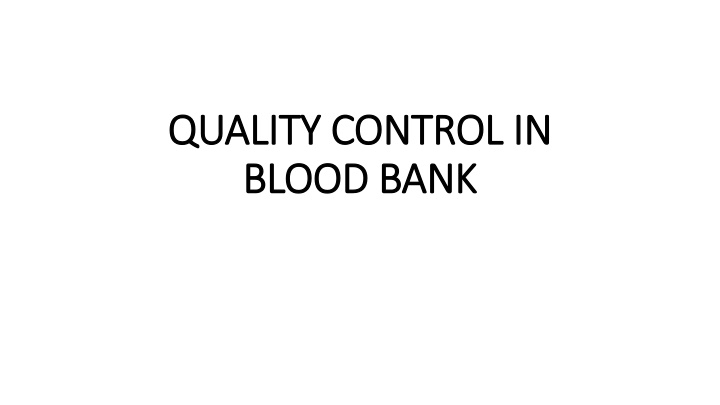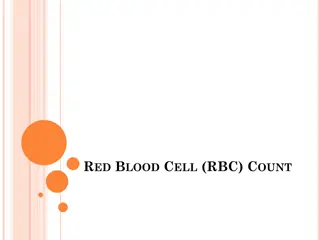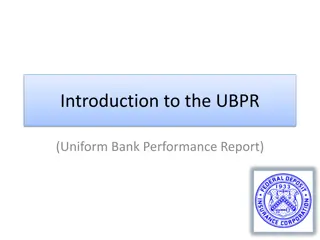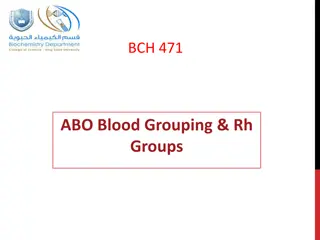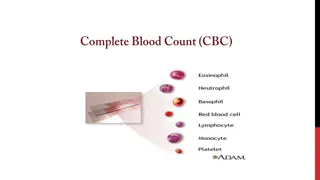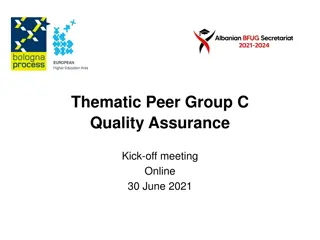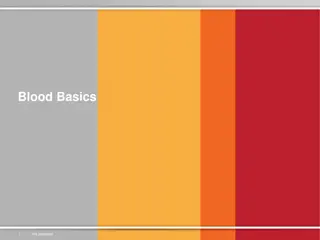Comprehensive Overview of Quality Control in Blood Bank and Quality Assurance
In this detailed content piece, we delve into the realms of quality control and assurance in blood banks, emphasizing the crucial aspects such as quality system essentials, internal and external quality control procedures, and the significance of quality assurance in ensuring products meet required standards. The content also explores the types of quality control, highlighting the importance of monitoring, assessment, and process improvement for maintaining quality control standards.
Download Presentation

Please find below an Image/Link to download the presentation.
The content on the website is provided AS IS for your information and personal use only. It may not be sold, licensed, or shared on other websites without obtaining consent from the author.If you encounter any issues during the download, it is possible that the publisher has removed the file from their server.
You are allowed to download the files provided on this website for personal or commercial use, subject to the condition that they are used lawfully. All files are the property of their respective owners.
The content on the website is provided AS IS for your information and personal use only. It may not be sold, licensed, or shared on other websites without obtaining consent from the author.
E N D
Presentation Transcript
QUALITY CONTROL IN QUALITY CONTROL IN BLOOD BANK BLOOD BANK
Content Content Definition Types Need Inclusions How to do that?
Quality Assurance Quality Assurance It is the sum total of the organized arrangements with the objective of ensuring that products will be of the quality required for their intended use. It includes retrospective review and analysis of operational performance data to determine that the overall process is in a state of control and to detect shift or trends that require attention.
Quality Control Quality Control Testing routinely performed tests/activities on materials and equipments to check their proper function The monitoring system that checks the effectiveness of existing process/steps by testing the quality of final products
Quality System Essentials (QSEs) Quality System Essentials (QSEs) 1. 2. 3. 4. 5. 6. 7. 8. 9. 10. Management of non conforming events 11. Monitoring and assessment 12. Process improvement Organization and leadership Facilities work environment and safety Human resources Customer focus Suppliers and material management Equipment management Process management Documents and records Information management
Types Types Internal Quality control External Quality Control
Internal Control Internal Control The internal quality control can be maintained by going through a complete checklist of items or test daily to make sure that all systems are being monitored and in control. Immediate decisions can be taken to accept or reject results / products.
External Quality Control External Quality Control External quality control is a way to compare the performance of a laboratory with reference to other laboratories External Quality Assurance also know as proficiency testing or External Quality control
Quality in Blood Transfusion Services Quality in Blood Transfusion Services In blood transfusion service, the primary goal of quality is 'transfusion of safe unit of blood.' The quality system deals with all aspects to ensure that the product or 'safe unit of blood' is as safe as possible.
Objectives of Quality in Blood Bank Objectives of Quality in Blood Bank To ensure availability of a sufficient supply of blood, blood components of high quality with maximum efficacy and minimum risk to both donors and patients. To determine problems in the whole transfusion chain and solve it to achieve the goal .
Quality Management System in Blood Bank Quality Management System in Blood Bank In a blood transfusion center, it means that a management system should exist to look into provision of a safe unit of blood and if any errors are identified, these should be corrected.
Steps involving Quality Control in Steps involving Quality Control in Blood Bank Blood Bank Donor selection and Blood collection Serology Laboratory Transfusion transmitted Infection Component preparation Cross-match & Antibody screening Storage , issue and transportation
Need for Quality Need for Quality A failure in the quality of blood collected or screening of donated blood unit can be very serious and may result in fatal consequences. 1. Failure to identify the patient correctly 2. Wrong sample labeling 3. Mix-up of results amongst different patients 4. Failure to detect presence of an abnormality in the patient's sample 5. Issue of unscreened blood due to clerical or technical errors
Quality Control for Reagents Quality Control for Reagents The primary objective of a reagent quality control is to ensure that reagent is functioning as expected.
Quality Control for Reagents Quality Control for Reagents Reagent requirements All reagents should be clearly labeled with batch number, expiry date and storage temp; Instructions for use should be in-form of SOP s with training. All reagents and kit should be used according to the manufacturer s instructions. FIFO shall be maintained
Quality Control for Reagents Quality Control for Reagents Use of positive & negative controls should be done with each batch to show that reagents are potent and specific. All reagents must be carefully stored at recommended temp. Reagents to be kept at 4-6oC should never be frozen and are stored according to manufacturer s instructions only Supply, storage and transportation of kits and reagents should be strictly standardized & manufacturer s instructions should be followed with ensured continuous power supply and periodic temperature monitoring.
Log of Reagents Log of Reagents Reagent records should include: The name of each reagent with Lot number Batch number Expiry date Name of manufacturer Date of receipt and put in use Grade and strength of reactions at time of receipt (Kit verification).
Frequency of Quality Control of Reagent Reagents Frequency of testing along with Controls Anti human serum Each day of use Blood grouping serum Each day of use Antibody screening and reverse grouping cells Each day of use Enzymes Each run Normal saline (LISS and BPS) Each day of use Bovine albumin Each day of use
Quality Control of Reagent Red Blood Cells Parameters Quality Requirement Frequency of Control Appearance No haemolysis or turbidity in supernatant by visual inspections Each day Reactivity and specificity Positive reactions with known sera against red blood cells antigens Each day
Quality Control of ABO Reagent (Anti-A, Anti-B and Anti-AB) Parameters Quality Requirement Frequency of Control Appearance No turbidity, precipitate, particles or gel formation by visual inspection Specificity Positive reaction with red cells having corresponding antigen(s); and no reaction with negative control Avidity Macroscopic agglutination with 50% red cells suspension in homologous serum/normal saline using the slide test; 10 seconds for anti-A, anti-B and anti-AB with A1 and/or B cells at R.T; 20 seconds with A2 and A2B cells. Each day Daily and of each new lot/batch Daily and of each new lot/batch Reactivity No immune haemolysis, rouleaux formation or Prozone Undiluted serum should give +++reactions in saline tube test using a 3% red cells suspensions at R.T., titre should be 256 for anti-A, anti-B, and anti-AB with A1 and/or B cells, 64 with A2 and A2B cells. Each new lot/batch. Potency Each new lot/batch.
Quality Acceptable of Rh Anti-sera (Anti-D) Parameter Quality requirement Frequency of control Appearance No turbidity, precipitation, particles or gel formation by visual inspection Positive reaction with R1r cells / Known D Positive cells Each day Specificity Each day and each new lot/batch. And no reaction with rr cells. Each day and each new lot/batch Avidity Visible agglutination with 40% red cells suspension in homologous serum using the slide test. Reactivity No immune haemolysis, rouleaux formation or prozone phenomenon. Undiluted serum gives +++ reactions in designated test for each serum and a titre 32- 64 for anti-D. Each new lot/batch Potency Each new lot/batch
Acceptable Titre and Avidity of ABO Reagents Anti-sera Type of the reagent Type of red cells Titre Avidity Time Intensity (2-3% cells suspension) Anti-A Polyclonal Monoclonal A1 A2 A2B O B A1 A2 A2B O B 1:256 1:128 1:64 - - 1:256 1:128 1:64 - - 10-12 sec 15-18 sec 15-18 sec - - 3.4 sec 5-6 sec 5-6 sec - - +++ ++ To +++ ++ - - +++ ++ To +++ ++++ - - Anti-B Polyclonal Monoclonal B A1B O A1 B A1B O A1 1:256 1:128 - - 1:256 1:128 - - 10-12 sec 12-15 sec - - 3-4 sec 5-6 sec - - +++ ++ - - ++++ +++ - - Anti-AB Polyclonal Monoclonal A1 B A2 O A1 B A2 O 1:256 1:256 1:64 - 1:256 1:256 1:128 - 10-12 sec 10-12 sec 15-18 sec - 3-4 sec 3-4 sec 5-6 sec - +++ +++ ++ To +++ - ++++ ++++ +++ -
Acceptable Quality of Anti-globulin (Gel / Beads) Reagent Parameter Appearance Quality requirement No precipitate, particles or gel formation by visual in inspection. No prozone phenomenon No haemolysis or agglutination of unsensitized red cells Agglutination of red cells sensitised with anti-D serum containing not more than 0.2 mg/ml antibody activity Frequency of control Each day Reactivity and Specificity Each lot Each day Each day and each new lot/batch.
Transfusion Transmitted Infection testing Done in Blood Bank Transfusion Transmitted Infection testing Done in Blood Bank HBs Ag HIV 1 & 2 HCV Syphilis Malaria Parasite
Frequency of Transfusion Transmitted disease Frequency of Transfusion Transmitted disease Reagents Frequency of testing along with controls Hepatitis B Antigen Each run HIV 1 & 2 Antibody Each run Hepatitis C Virus Each run Syphilis serology reagents Each run Malaria Test Each run
Assuring quality of examination procedure Assuring quality of examination procedure The daily QC values shall be documented on Levey Jennings curve and CV % from monthly QC data must be calculated.
Flow chart should be made to manage Out of control situation If a reagent produces results outside the limits set by the manufacturer or Blood Bank, the deficiency should be reported to the Quality Manager. Search for recent events that could have caused changes Examine environmental condition Follow manufactures troubleshooting guide Refer to manufacturer of equipment, reagents or QC/Calibrator vendor.
Quality Control in Blood/ Blood Components Quality Control in Blood/ Blood Components Frequency of Testing 1% of component shall be tested for Quality Control out of which 75% shall match the acceptable ranges as per National guidelines set by Govt. of India(DGHS).
QC of blood/blood component preparation 1. Whole blood: Frequency of control: 1% of all units with minimum of 4 units per month Storage :- 2 C to 6 C, for CPDA-1 the storage time is 35 days, CPD & CD2D 22days. Parameter Quantity Requirement Frequency of Control Volume 350/450 ml + 10% 1% of all units Anticoagulants 49/63 ml All units PCV (Hct) 30 to 40% 4 units per month HBsAg Negative by ELISA All units Anti-HCV Negative by ELISA All units Anti-HIV Negative by ELISA All units Syphilis Negative by Screening test All units Sterility By culture Periodically (1% of all units)
Calculation for Total Volume of Whole Blood taken in 450 ml of Bag Volume of Whole Blood: 450 ml 10% OR 472 gms. 10% Calculate the volume from the formula given below: Weight of the Bag with Blood (gms) Weight of the empty Bag (with Anticoagulant) Volume (ml) = 1.05 * Weight of the empty Bag (with Anticoagulant) of 450 ml = 100 gms
2. Red cell concentrates Perform the same assay as for Whole blood Storage : 2o-6 C, for 35 days if prepared from WB collected in CPDA-1 The Quality Control of red cell concentrate (Prepared from 450 ml Blood) Parameter Quantity Requirement Frequency of Control Volume 280 + 40 ml 1% of all units PCV (Hct) 70%+ 5% Periodically (1% of all units) The Quality Control of red cell in preservative sol. (ADSOL/SAGM) Parameter Quantity Requirement Frequency of Control Volume 350 + 20 ml 1% of all units PCV (Hct) 55-65% Periodically (1% of all units)
3. Platelet concentrates Prepared within 6 hours of blood collection Must evaluate at least 1% of platelets monthly for platelet count, pH and plasma volume Platelets should be selected from each centrifuge in use Storage : 20o-24 C Parameter Quality Requirements Frequency of control Volume 50-70 ml All units Platelets count > 5.5 x 1010 4 units per month/ 1% of all units (whichever is more) pH >6.0 4 units per month/ 1% of all units (whichever is more) RBC contamination 0.5 ml 4 units per month/ 1% of all units (whichever is more) WBC contamination 5.5x107 5x108 4 units per month/ 1% of all units (whichever is more)
4. Quality of Platelet concentrate by Apheresis Parameter Quality requirement Volume >200 ml Platelets count > 3.0 7.0 x 1011 pH > 6.0 (at the end of permissible storage period) Residual leucocytes < 5.0 x 106 Red cells Traces to 0.5 ml
5. Fresh Frozen Plasma frozen within 6 hours of blood collection using 80oC deep freezers or blast freezers Stored at 30oC Date of expiry one year Parameter Quality control Frequency of control Volume 200 220 Plasma 4 units per month/ 1% of all units (whichever is more) Stable coagulation factors 200 units of each factor 4 units per month Factor VIII 0.7 units/ml 4 units per month Fibrinogen 200 400 mg 4 units per month
6. Cryoprecipitate Parameter Quality control Frequency of control Volume 10 20 ml 1% of all units Factor VIII 80 120 units 1% of all units Fibrinogen 150 250 mg 1% of all units
Labeling Unique identification number ABO and Rh type Date of collection and expiry TTI screening sticker Volume of component
Storage Refrigerators External ambient temperature Range: 2 to 6 C Continuous monitor temperature chart to record fluctuations - THERMOGRAPHS: Changed weekly & preserve records Bacterial cultures Audible and visual alarm signal Digital temperature display
Deep freezers Temperature recording : Range: -35 C to -40 C Cooling down time: A full load of plasma packs at +25 C takes a max. of 5 hrs for all the packs to reach below -5 C and 30 hrs to below -20 C
Platelet agitator All PCs to be stored only in agitators: continuous gentle flat bedded 5 days Interruption compromises the viability Temperature monitoring Swirling to be checked before issue Regular Quality Control of RDPs and AP-PCs
External Quality Assurance (EQA) Proficiency Testing Programme is designed to evaluate the overall performance and accuracy engaged in blood banking testing. Determine the performance of Individual Blood banks for specific tests or measurement and to monitor Blood Banks continual performance and improvement. To provide additional confidence to Blood Bank / Laboratory clients. It is a blind testing
External Quality Assurance The internal QC should be complemented by regular external quality assurance e.g. participation in a proficiency testing programme Proficiency programme test, coded normal and problem blood samples are distributed from national or regional reference laboratory to the participants usually 2x to 4x a year.
Parameters / test covered under EQA 1. HBsAg 2. Anti- HIV 1&2 3. Anti- HCV 4. Syphilis (VDRL) 5. Malarial Parasite 6. NAT ( HBV/ HCV/ HIV-1, HIV-2, HIV-O & HIV-M) 7. Hemoglobin 8. Blood Group 9. Cross-match 10. Antibody Screening & Identification 11. Factor VIII 12. Fibrinogen 13. Sterility Testing 14. APTT
